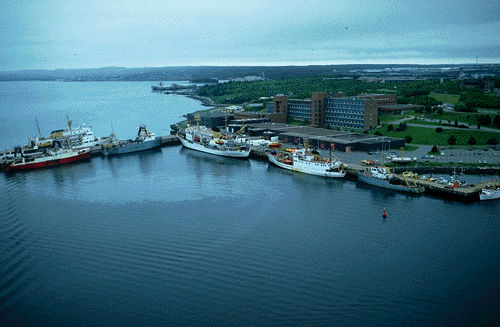Browse "Science & Technology"
-
Article
Northern Railway of Canada
The railway was designed to link the 3 lakes for which it was originally named - the Ontario, Simcoe and Huron Railway. It opened in May 1853 when the locomotive Toronto (made in Toronto) hauled the first steam train in present-day Ontario from Toronto to Machell's Corners (present-day Aurora).
"https://development.thecanadianencyclopedia.ca/images/tce_placeholder.jpg?v=e9dca980c9bdb3aa11e832e7ea94f5d9" // resources/views/front/categories/view.blade.php
https://development.thecanadianencyclopedia.ca/images/tce_placeholder.jpg?v=e9dca980c9bdb3aa11e832e7ea94f5d9
-
"https://development.thecanadianencyclopedia.ca/images/tce_placeholder.jpg?v=e9dca980c9bdb3aa11e832e7ea94f5d9" // resources/views/front/categories/view.blade.php
https://development.thecanadianencyclopedia.ca/images/tce_placeholder.jpg?v=e9dca980c9bdb3aa11e832e7ea94f5d9
-
Article
NOVA Corporation
NOVA Corporation was a Canadian energy company based in Calgary. Originally known as the Alberta Gas Trunk Line Company Ltd., it was established in 1954 to build, own and operate Alberta’s natural gas gathering and transmission facilities. In 1998, NOVA merged with TransCanada (now TC Energy), creating the fourth largest gas pipeline company in North America.
"https://development.thecanadianencyclopedia.ca/images/tce_placeholder.jpg?v=e9dca980c9bdb3aa11e832e7ea94f5d9" // resources/views/front/categories/view.blade.php
https://development.thecanadianencyclopedia.ca/images/tce_placeholder.jpg?v=e9dca980c9bdb3aa11e832e7ea94f5d9
-
Article
Nova Scotia Nautical Institute
The Nova Scotia Nautical Institute was an institute for seamanship training founded in 1872. It was common in England and Canada, which followed England in marine matters, to have people called "crammers" to assist mariners to pass their examinations, following apprenticeship on board ship.
"https://development.thecanadianencyclopedia.ca/images/tce_placeholder.jpg?v=e9dca980c9bdb3aa11e832e7ea94f5d9" // resources/views/front/categories/view.blade.php
https://development.thecanadianencyclopedia.ca/images/tce_placeholder.jpg?v=e9dca980c9bdb3aa11e832e7ea94f5d9
-
Article
Nuclear Energy
Nuclear Energy is energy from the nucleus of an atom. In stars such as the sun, pairs of light atoms (mostly hydrogen) fuse together and release the radiation received on earth as solar energy.
"https://development.thecanadianencyclopedia.ca/images/tce_placeholder.jpg?v=e9dca980c9bdb3aa11e832e7ea94f5d9" // resources/views/front/categories/view.blade.php
https://development.thecanadianencyclopedia.ca/images/tce_placeholder.jpg?v=e9dca980c9bdb3aa11e832e7ea94f5d9
-
Article
Nuclear Fusion
Nuclear fusion is the combination of the nuclei of two light atoms to form a heavier one. The resulting atom has a smaller mass than the original ones; therefore, nuclear fusion is a method of transforming mass into energy.
"https://development.thecanadianencyclopedia.ca/images/tce_placeholder.jpg?v=e9dca980c9bdb3aa11e832e7ea94f5d9" // resources/views/front/categories/view.blade.php
https://development.thecanadianencyclopedia.ca/images/tce_placeholder.jpg?v=e9dca980c9bdb3aa11e832e7ea94f5d9
-
Article
Nuclear Power Plants
Nuclear power plants have been used in Canada since the early 1960s to produce electricity commercially. In 2024, approximately 15% of the country’s electricity was procured by nuclear energy. The province of Ontario is home to three of Canada’s five plants, with the other two located in Quebec and New Brunswick, respectively. The Quebec plant (Gentilly-2 Nuclear Facility) ceased operations in December 2012. The full decommissioning process is scheduled to end in 2074.
"https://development.thecanadianencyclopedia.ca/images/tce_placeholder.jpg?v=e9dca980c9bdb3aa11e832e7ea94f5d9" // resources/views/front/categories/view.blade.php
https://development.thecanadianencyclopedia.ca/images/tce_placeholder.jpg?v=e9dca980c9bdb3aa11e832e7ea94f5d9
-
Article
Nuclear Research Establishments
The research company of Atomic Energy of Canada LTD (AECL) operates 2 major nuclear energy research centres in Canada: Chalk River Nuclear Laboratories (CRNL), and Whiteshell Nuclear Research Establishment (WNRE).
"https://development.thecanadianencyclopedia.ca/images/tce_placeholder.jpg?v=e9dca980c9bdb3aa11e832e7ea94f5d9" // resources/views/front/categories/view.blade.php
https://development.thecanadianencyclopedia.ca/images/tce_placeholder.jpg?v=e9dca980c9bdb3aa11e832e7ea94f5d9
-
Article
Nursing
Marie Rollet Hébert [Hubou] has been credited with being the first person in what is now Canada to provide nursing care to the sick. The wife of Louis HÉBERT, a surgeon-apothecary, she arrived in Québec in 1617 and assisted her husband in caring for the sick.
"https://d2ttikhf7xbzbs.cloudfront.net/media/media/08deff50-6a3a-4687-8f30-5a0c2c7c2da2.jpg" // resources/views/front/categories/view.blade.php
https://d2ttikhf7xbzbs.cloudfront.net/media/media/08deff50-6a3a-4687-8f30-5a0c2c7c2da2.jpg
-
Article
Observatory
Of the observatories in use before the invention of the telescope, perhaps the most scientifically productive was that of Tycho Brahe, built 400 years ago on the island of Hveen in the Baltic Sea.
"https://d2ttikhf7xbzbs.cloudfront.net/media/media/e017ec41-8b62-49c2-8cd4-78fd183ba8be.jpg" // resources/views/front/categories/view.blade.php
https://d2ttikhf7xbzbs.cloudfront.net/media/media/e017ec41-8b62-49c2-8cd4-78fd183ba8be.jpg
-
Article
Occupational Diseases
Occupational diseases are disorders of health resulting from conditions related to the workplace. They are distinguished from occupational injuries, which are disorders resulting from trauma such as strains or sprains, lacerations, burns or soft-tissue injuries such as bruises.
"https://development.thecanadianencyclopedia.ca/images/tce_placeholder.jpg?v=e9dca980c9bdb3aa11e832e7ea94f5d9" // resources/views/front/categories/view.blade.php
https://development.thecanadianencyclopedia.ca/images/tce_placeholder.jpg?v=e9dca980c9bdb3aa11e832e7ea94f5d9
-
Article
Ocean Ranger
On 15 February 1982, the world's largest semisubmersible drill rig, Ocean Ranger, capsized and sank in a fierce storm on the Grand Banks with the loss of all 84 crew members, 56 of whom were Newfoundlanders.
"https://d2ttikhf7xbzbs.cloudfront.net/media/media/ba211737-bc16-4975-8314-d58fecb69691.jpg" // resources/views/front/categories/view.blade.php
https://d2ttikhf7xbzbs.cloudfront.net/media/media/ba211737-bc16-4975-8314-d58fecb69691.jpg
-
Article
Oceanography
From descriptive beginnings as the geography of the sea, oceanography has matured into a quantitative and multidisciplinary science bringing together experts from many basic fields.
"https://d2ttikhf7xbzbs.cloudfront.net/media/media/c584d662-8432-4be5-8f12-452cab3d3a57.jpg" // resources/views/front/categories/view.blade.php
https://d2ttikhf7xbzbs.cloudfront.net/media/media/c584d662-8432-4be5-8f12-452cab3d3a57.jpg
-
Article
Office Automation
Office Automation is a general term that includes a wide range of applications of computer, communication and information technologies in office environments. Though automation is in a continual state of flux, the size of the market is huge, with annual investments measured in billions of dollars.
"https://development.thecanadianencyclopedia.ca/images/tce_placeholder.jpg?v=e9dca980c9bdb3aa11e832e7ea94f5d9" // resources/views/front/categories/view.blade.php
https://development.thecanadianencyclopedia.ca/images/tce_placeholder.jpg?v=e9dca980c9bdb3aa11e832e7ea94f5d9
-
Article
Offshore Mineral Rights Reference
The Supreme Court of Canada, in a decision about the ownership of seabed mineral rights off BC and on the legislative jurisdiction over these rights, decided in 1967 that Parliament, not the BC legislature, owned the territorial seabed adjacent to that province and enjoyed exclusive legislative jurisdiction by virtue of the Constitution Act, 1867 (s91.1A), ie, Parliament's residuary power. Rights in the territorial sea derive from international law and Canada is the sovereign state recognized...
"https://development.thecanadianencyclopedia.ca/images/tce_placeholder.jpg?v=e9dca980c9bdb3aa11e832e7ea94f5d9" // resources/views/front/categories/view.blade.php
https://development.thecanadianencyclopedia.ca/images/tce_placeholder.jpg?v=e9dca980c9bdb3aa11e832e7ea94f5d9
